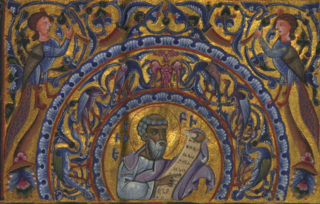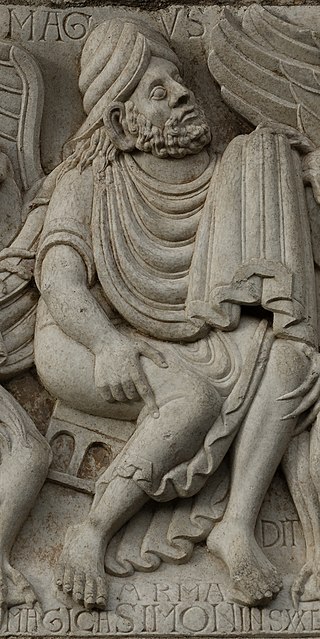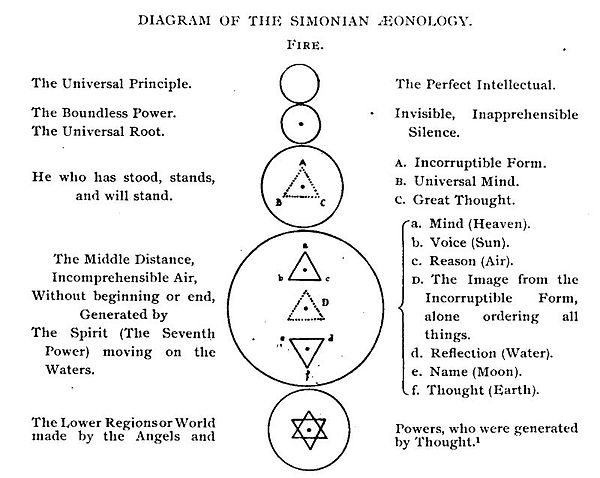
Eusebius of Caesarea, also known as Eusebius Pamphilus, was a Greek Syro-Palestinian historian of Christianity, exegete, and Christian polemicist. In about AD 314 he became the bishop of Caesarea Maritima in the Roman province of Syria Palaestina. Together with Pamphilus, he was a scholar of the biblical canon and is regarded as one of the most learned Christians during late antiquity. He wrote Demonstrations of the Gospel, Preparations for the Gospel and On Discrepancies between the Gospels, studies of the biblical text. As "Father of Church History", he produced the Ecclesiastical History, On the Life of Pamphilus, the Chronicle and On the Martyrs. He also produced a biographical work on Constantine the Great, the first Christian Roman emperor, who was Augustus between AD 306 and AD 337.

Gnosticism is a collection of religious ideas and systems that coalesced in the late 1st century AD among Jewish and early Christian sects. These various groups emphasized personal spiritual knowledge (gnosis) above the proto-orthodox teachings, traditions, and authority of religious institutions. Gnostic cosmogony generally presents a distinction between a supreme, hidden God and a malevolent lesser divinity who is responsible for creating the material universe. Consequently, Gnostics considered material existence flawed or evil, and held the principal element of salvation to be direct knowledge of the hidden divinity, attained via mystical or esoteric insight. Many Gnostic texts deal not in concepts of sin and repentance, but with illusion and enlightenment.

Origen of Alexandria, also known as Origen Adamantius, was an early Christian scholar, ascetic, and theologian who was born and spent the first half of his career in Alexandria. He was a prolific writer who wrote roughly 2,000 treatises in multiple branches of theology, including textual criticism, biblical exegesis and hermeneutics, homiletics, and spirituality. He was one of the most influential and controversial figures in early Christian theology, apologetics, and asceticism. He has been described as "the greatest genius the early church ever produced".

Simon Magus, also known as Simon the Sorcerer or Simon the Magician, was a religious figure whose confrontation with Peter is recorded in the Acts of the Apostles. The act of simony, or paying for position, is named after Simon, who tried to buy his way into the power of the Apostles.
Nicolaism was an early Christian sect mentioned twice in the Book of Revelation of the New Testament. The adherents were called Nicolaitans, Nicolaitanes, or Nicolaites. They were considered heretical by the mainstream early Christian Church. According to Revelation 2:6 and 15, they were known in the cities of Ephesus and Pergamum. In this chapter, the church at Ephesus is endorsed for "[hating] the works of the Nicolaites, which I also hate"; and the church in Pergamos is rebuked: "So thou hast also some [worshiping in their midst] who hold the teaching of the Nicolaites". In the original Greek, they are called Νικολαϊτῶν (Nikolaitōn).

Ebionites as a term refers to a Jewish Christian sect, which viewed poverty as a blessing, that existed during the early centuries of the Common Era. The Ebionites embraced an adoptionist Christology, thus understanding Jesus of Nazareth as a mere man who, by virtue of his righteousness in following the Law of Moses, was chosen by God to be the messianic "prophet like Moses". A majority of the Ebionites rejected as heresies the orthodox Christian beliefs in Jesus' divinity, virgin birth and substitutionary atonement; and therefore maintained that Jesus was born the natural son of Joseph and Mary, sought to abolish animal sacrifices by prophetic proclamation, and died as a martyr in order to move all Israel to repentance.
The Ophites, also called Ophians, were a Christian Gnostic sect depicted by Hippolytus of Rome (170–235) in a lost work, the Syntagma ("arrangement").
Cerinthus was an early Gnostic, who was prominent as a heresiarch in the view of the early Church Fathers. Contrary to the Church Fathers, he used the Gospel of Cerinthus, and denied that the Supreme God made the physical world. In Cerinthus' interpretation, the Christ descended upon Jesus at baptism and guided him in ministry and the performing of miracles, but left him at the crucifixion. Similarly to the Ebionites, he maintained that Jesus was not born of a virgin, but was a mere man, the biological son of Mary and Joseph.
Basilides was an early Christian Gnostic religious teacher in Alexandria, Egypt who taught from 117 to 138 AD, and claimed to have inherited his teachings from the apostle Saint Matthias. He was a pupil of either the Simonian teacher Menander, or a supposed disciple of Peter named Glaucias. The Acts of the Disputation with Manes state that for a time he taught among the Persians. According to Agapius of Hierapolis he appeared in the 15th year of Trajan reign. He is believed to have written over two dozen books of commentary on the Christian Gospel entitled Exegetica, making him one of the earliest Gospel commentators.
Symmachus was a writer who translated the Old Testament into Greek. His translation was included by Origen in his Hexapla and Tetrapla, which compared various versions of the Old Testament side by side with the Septuagint. Some fragments of Symmachus's version that survive, in what remains of the Hexapla, inspire scholars to remark on the purity and idiomatic elegance of Symmachus' Greek. He was admired by Jerome, who used his work in composing the Vulgate.
The Basilidians or Basilideans were a Gnostic sect founded by Basilides of Alexandria in the 2nd century. Basilides claimed to have been taught his doctrines by Glaucus, a disciple of St. Peter, though others stated he was a disciple of the Simonian Menander.
Saint Pamphilus, was a presbyter of Caesarea and chief among the biblical scholars of his generation. He was the friend and teacher of Eusebius of Caesarea, who recorded details of his career in a three-book Vita that has been lost.
Dositheos was a Samaritan religious leader. He was the founder of a Samaritan sect often assumed to be Gnostic in nature, and is reputed to have known John the Baptist, and been either a teacher or a rival of Simon Magus.

The Elcesaites, Elkasaites, Elkesaites or Elchasaites were an ancient Jewish Christian sect in Lower Mesopotamia, then the province of Asoristan in the Sasanian Empire that was active between 100 and 400 CE. The members of this sect, which originated in the Transjordan, performed frequent baptisms for purification and had a Gnostic orientation.
The Refutation of All Heresies, also called the Elenchus or Philosophumena, is a compendious Christian polemical work of the early third century, whose attribution to Hippolytus of Rome or an unknown "Pseudo-Hippolytus" is disputed. It catalogues both pagan beliefs and 33 gnostic Christian systems deemed heretical by Hippolytus, making it a major source of information on contemporary opponents of Christian orthodoxy as understood today.
Cerdo was a Syrian Gnostic who was deemed a heretic by the Early Church around the time of his teaching, circa 138 AD. Cerdo started out as a follower of Simon Magus, like Basilides and Saturninus, and taught at about the same time as Valentinus and Marcion. According to Irenaeus, he was a contemporary of the Roman bishop Hyginus, residing in Rome as a prominent member of the Church until his forced expulsion therefrom.
In many Gnostic systems, various emanations of God are known by such names as One, Monad, Aion teleos, Bythos, Arkhe, Proarkhe and as Aeons. In different systems these emanations are differently named, classified, and described. In Basilidian Gnosis they are called sonships ; according to Marcus, they are numbers and sounds; in Valentinianism they form male/female pairs called syzygies.
Sophia is a major theme, along with Knowledge, among many of the early Christian knowledge theologies grouped by the heresiologist Irenaeus as gnostikoi (γνωστικοί), "knowing" or "men that claimed to have deeper wisdom". Gnosticism is a 17th-century term expanding the definition of Irenaeus' groups to include other syncretic faiths and the Greco-Roman mysteries.
Menander was a first-century CE Samaritan Gnostic and magician. He belonged to the school of the Simonians, becoming its leader after the death of his master and instructor, Simon Magus, who was in Rome during the reign of Emperor Claudius.






